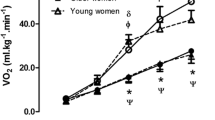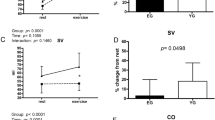Abstract
The aims of the present study were to define the respective roles of the cardiac and respiratory response to exercise as determinants of the age- related physiological decrease in exercise performance, and to assess the relationship between aging and interindividual variability in the response to effort. We studied 91 normal subjects recruited in three age- groups: Group A (42 children, aged 10± 2 years); Group B (29 young adults, aged 27± 5 years); Group C (20 elderly, aged 74± 9 years). All the subjects underwent an incremental cycle ergometer exercise test with a work load increase of 15 W every 2 minutes in groups A and C, and 25 W every 2 minutes in group B, until they achieved 80% of the predicted maximal heart rate. Ventilatory equivalent changes during exercise were significantly lower in group A than in the other two groups, and in group B compared to group C. Exercise- induced changes in oxygen pulse were significantly higher in group A, but no difference was found between groups B and C. Thus, gas- exchange function and overall exercise performance decrease with advancing age, whereas cardiovascular performance is well maintained in normal elderly subjects. Discriminant analysis showed that the exercise response conformed to the group- specific model in 74% and 79% of subjects in groups A and B, but only in 50% of the group C subjects; 5% and 45% of the elderly subjects were functionally classified in groups A and B, respectively. On the basis of these data, it may be concluded that aging accounts for a dramatic increase in interindividual variability in adaptation to physical effort, and that the inverse relationship between age and exercise performance is mainly related to the declining efficacy of the respiratory response to effort with age. (Aging Clin. Exp. Res. 6: 267–275, 1994)
Similar content being viewed by others
References
Wagner P.D., Hoppeler H., Saltin B.: Determinants of maximal oxygen uptake. In: Crystal R.G., West J.B. (Eds.), The lung: scientific foundations. Raven Press, New York, 1991, pp. 1585–1593.
Gerstenblith G., Lakatta E.G., Weisfeldt M.L.: Age changes in myocardial function and exercise response. Prog. Cardiovasc. Dis. 19: 1–21, 1976.
Strandeil T.: Circulatory studies on healthy old men. Acta Med. Scand. 175 (Suppl. 414): 1–44, 1964.
Con way J., Wheeler R., Sannerstedt R.: Sympathetic nervous activity during exercise in relation to age. Cardiovasc. Res. 5: 577–581, 1971.
Rodeheffer R.J., Gerstenblith G., Becker L.C., Fleg J.L., Weisfeldt M.L., Lakatta E.G.: Exercise cardiac output is maintained with advancing age in healthy human subjects: cardiac dilatation and increased stroke volume compensate for a diminished heart rate. Circulation 69: 203–213, 1984.
Fleg J.L., Goldberg A.P.: Exercise in older people: cardiovascular and metabolic adaptations. In: Hazzard W.R., Andres R., Bierman E.L., Blass J.P. (Eds.), Principles of geriatric medicine and gerontology, ed. 2. McGraw-Hill, New York, 1990, pp. 85–100.
Weisfeldt M.L., Lakatta E.G., Gerstenblith G.: Aging and the heart. In: Braunwald E. (Ed.), Heart disease, ed. 4. WB Saunders, Philadelphia, 1992, pp. 1656–1669.
Rowe J.W.: Aging and geriatric medicine. In: Wyngaarden J.B., Smith L.H. Jr, Bennett J.C. (Eds.), Cecil Textbook of medicine, ed. 19. WB Saunders, Philadelphia, 1992, pp. 21–26.
Jones N.L., Summers E., Killian K.J.: Influence of age and stature on exercise capacity during incremental cycle ergometry in men and women. Am. Rev. Respir. Dis. 140: 1373–1380, 1989.
Astrand P.O., Rodahl K.: Textbook of work physiology, ed. 3. McGraw-Hill, New York, 1986.
Jones N.L., Makrides L., Hitchcock C., Chypchar T., McCartney N.: Normal standards for an incremental progressive cycle ergometer test. Am. Rev. Respir. Dis. 131: 700–708, 1985.
Feigenbaum H.: Echocardiography, ed. 4. Lea & Febiger, Philadelphia, 1986.
Knudson R.J., Slatin R.C., Lebowitz M.D., Burrows B.: The maximal expiratory flow-volume curve. Normal standards, variability and effects of age. Am. Rev. Respir. Dis. 113: 587–600, 1976.
Mitchell C.O., Lipschitz D.A.: Detection of protein-calorie malnutrition in the elderly. Am. J. Clin. Nutr. 35: 398–406, 1982.
Jones N.L.: Clinical exercise testing, ed. 3. WB Saunders, Philadelphia, 1988.
Wasserman K., Whipp B.J.: Exercise physiology in health and disease. Am. Rev. Respir. Dis. 112: 219–249, 1975.
Spiro S.G.: Exercise testing in clinical medicine. Br. J. Dis. Chest 71: 145–172, 1977.
Mellerowicz H., Smodlaka V.N.: Ergometry. Basics of medical exercise testing. Urban-Schwarzenberg, Baltimore, 1981.
Snedecor G.W., Cochran W.G.: Statistical methods. The Iowa State University Press, Ames, Iowa, 1967.
Norusis M.J.: Predicting cure and credit: discriminant analysis. In: SPSS/PC+ Advanced Statistics V.2.0. SPSS Inc., Chicago, 1988, pp. B1–B39.
Jones N.L.: Physiological basis of exercise testing. In: Fishman A.P. (Ed.), Pulmonary diseases and disorders, ed. 2. McGraw-Hill, New York, 1988, pp. 235–250.
Gallagher C.G.: Exercise and chronic obstructive pulmonary disease. Med. Clin. North Am. 74: 619–641, 1990.
Askanazi J., Silverberg P.A., Foster R.J., Hyman A.I., Milic-Emili J., Kinney J.M.: Effects of respiratory apparatus on breathing pattern. J. Appl. Physiol.: Respirat. Environ. Exercise Physiol. 48: 577–580, 1980.
Anthonisen N.R., Danson J., Robertson P.C., Ross W.R.D.: Airway closure as a function of age. Resp. Physiol. 8: 58–65, 1969.
Nunn J.F.: Applied respiratory physiology, ed. 3. Butterworths, London, 1987.
Knudson R.J.: Physiology of the aging lung. In: Crystal R.G., West J.B. (Eds.), The lung: scientific foundations. Raven Press, New York, 1991, pp. 1749–1759.
Wait J.: Cardiopulmonary stress testing: a review of noninvasive approaches. Chest 90: 504–510, 1986.
Author information
Authors and Affiliations
Rights and permissions
About this article
Cite this article
Fuso, L., Antonelli Incalzi, R., Muzzolon, R. et al. The cardiopulmonary response to incremental exercise test: The effect of aging. Aging Clin Exp Res 6, 267–275 (1994). https://doi.org/10.1007/BF03324252
Received:
Accepted:
Published:
Issue Date:
DOI: https://doi.org/10.1007/BF03324252




